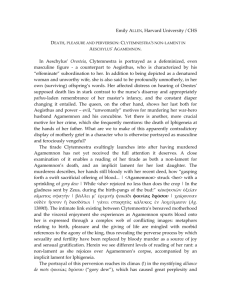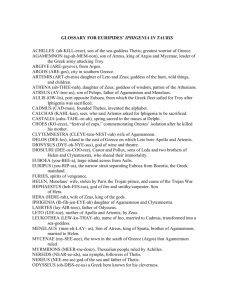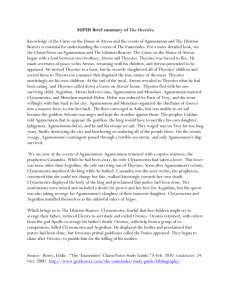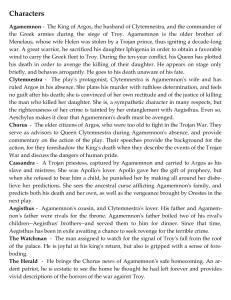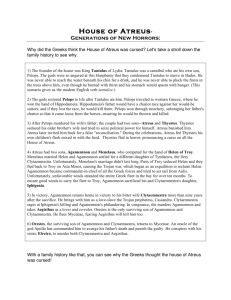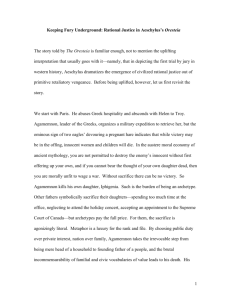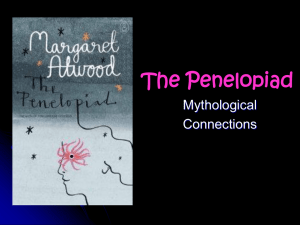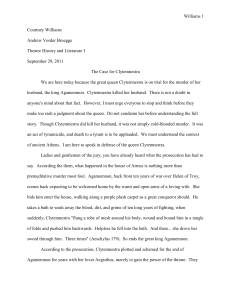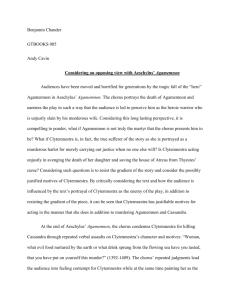The Mycenaean Saga - People Server at UNCW
advertisement
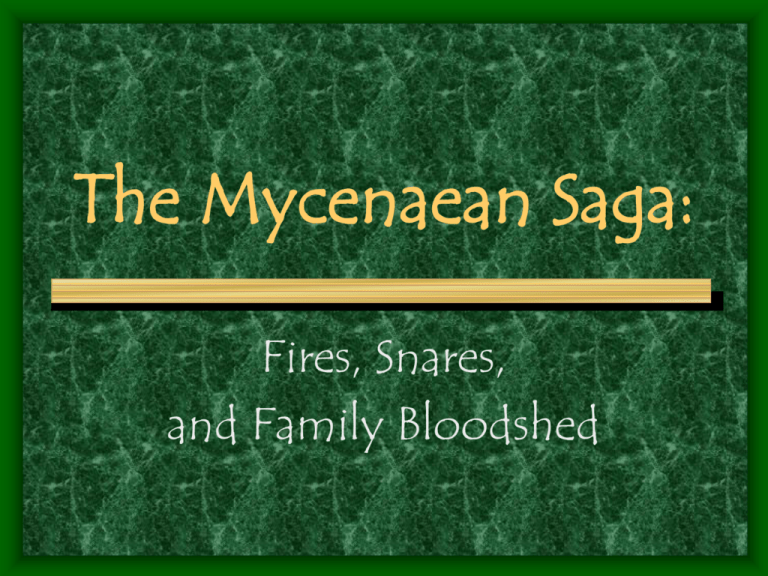
The Mycenaean Saga: Fires, Snares, and Family Bloodshed Pelops and Tantalus Like Europa, Pelops came to Greece from Asia. In a common folktale motif, he sought the hand of a princess through a contest which had already cost 12 other princes their lives. The contest was chariot racing against the girl’s father. Pelops has a fascinating childhood, since he was killed by his father, served to the gods in a stew, then reconstituted (except for a shoulder blade which had been eaten by Demeter – it was replaced with an ivory substitute). Pelops Win, you get married; lose, you get killed. Pelops cheated by bribing the father’s charioteer to sabotage the chariot. His future father in law was killed in the ensuing accident, and Pelops won. He then killed the charioteer. Pelops lived happily ever after, became the eponymous hero of the Peloponnese (central Greece), and was celebrated as a hero in rituals at Olympia. But his family was cursed. Atreus and Thyestes A prophecy had awarded the kingdom of Mycenae to whichever of Pelops’ sons, Atreus or Thyestes, had a golden-fleeced ram. The god Pan brought the ram to Atreus, who was already celebrating his kingship – When Thyestes showed up with the ram. He had gotten it by seducing Atreus’ wife, who then gave him the ram. Thyestes was king for a while, till Atreus expelled him. Then Atreus invited him over for a yummy reconciliation dinner. Atreus and Thyestes Atreus had cut up Thyestes’ young sons, and served them up to their father. When Thyestes discovered this, he was overcome by horror and went into exile. Thyestes was haunted by pollution, miasma, which infects you if you have done something awful, even if it was not your fault. He cursed his brother. Then Thyestes produced another son, Aegisthus, by impregnating his own daughter. Atreus had two sons, Agamemnon and Menelaus. Menelaus was chosen to marry the beautiful Helen of Sparta (a.k.a. Helen of Troy). Agamemnon had to make do with Helen’s sister, Clytemnestra. When Helen was kidnapped, Agamemnon led the mission to get her back. Sources Homer (c. 700 BCE) tells about the Trojan war in the Iliad, and alludes to several of the events leading up to it. In the Odyssey, he tells of what happened right after the war. In 458 BCE Aeschylus wrote the Oresteia, a trilogy of plays, about the murder of Agamemnon and its aftermath. It is the only extant trilogy. It is rare for all three plays in a trilogy to be on the same theme. The three pays are Agamemnon, The Libation Bearers, and The Eumenides. Sophocles wrote Electra (exact date unknown), showing a heroic account of the revenge of Orestes and Electra. Euripides wrote an Electra (416 BCE?) and an Orestes (?), both of which treat the two in a very uncomplimentary way. Sources The three Greek playwrights and Homer show a wide range of attitudes toward the story, and toward who is to blame for the slaughter within the family. Through these plays we see a range of the culture’s ideas about family rights and responsibilities. Seneca (Roman, 1st c. CE) wrote a very gory play, Thyestes, about that aspect of the story Many other sources make reference to the myths in passing. Art illustrates various scenes in ways which show different traditions of the stories. Levi-Strauss and Structuralism These versions show that the Greeks saw many complex meanings in this myth. it changed over time, and from author to author, and maybe even from person to person. Claude Levi-Strauss, in his theory of structuralism, argues that all of the different versions of the story constitute “The Story.” Myth is a mode of communication. The relationship between the elements of the story provide the structure of the myth. The basic structure of human thought is binary – that is, dealing with opposites. Therefore myths explore vital oppositions: life/death, primitive/new, light/darkness, chaotic/civilized, male/female. Through these oppositions, as played out in myth, we get an idea of the complex meanings of myth relative to that society’s issues. Sacrifice of Iphigeneia As the Greek ships got ready to sail to Troy, they were blocked by unfavorable winds sent by Artemis. The goddess demanded a human sacrifice. Since he was the commander, Agamemnon chose his own daughter, Iphigeneia. He got her to Aulis by deception. In some versions, she dies; in others, Artemis substitutes a deer at the last moment. But Clytemnestra thinks her daughter has been wantonly murdered. Sacrifice of Iphigeneia Euripides’ Iphigeneia at Aulis shows Clytemnestra as a concerned, though self-pitying, mother, and Agamemnon as a manipulative, uncaring father : While you’re at war, what kind of pain do you think my heart will feel as I wander through the rooms, and see her empty chair, her empty room . . . Is there anything I wouldn’t do to save my child? Obey, obey or a heavy doom will crush me – but doom will crush me once I kill my daughter, the glory of my house! Pain both ways and which is worse? Desert the fleets, fail the alliance? Law is law! Let all go well. But Aeschylus shows Agamemnon wrestling with his responsibility as a king and making a tragic, but justified, personal sacrifice. The Trojan War While Agamemnon is away at Troy, his wife Clytemnestra is left alone – but not for long. Aegisthus, Thyestes’ son (and grandson), appears and soon he and Clytemnestra are ruling together. Orestes, Agamemnon’s and Clytemnestra’s son, is sent away. Clytemnestra and Aegisthus plan to murder Agamemnon when he returns. When Aescylus’ Agamenon opens, a watchman is waiting for the signal fires Clytemnestra has arranged to warn her that Agamemnon is on his way home. Now I watch for the light, the signal fire breaking out of Troy . . . my thoughts go groping through the night . . . That woman [Clytemnestra] – she maneuvers like a man. Themes: light in darkness, male & female role reversal . . . The Murder of Agamemnon When Agamemnon returns, he expects a hero’s welcome. In Aeschylus, Clytemnestra tempts him to walk into the palace on a red carpet – hubris in Greek eyes, since such things are fit only for the gods. He objects, but gives in. Cassandra (his new slave) prophesies the murder of Agamemnon (though a bit incoherently) – no one understands. Inside, Clytemnestra bathes Agamemnon, then murders him in the bath. Other traditions show Aegisthus as the actual murderer. The Children’s Revenge Electra and Orestes, now almost adults, side with their murdered father and want revenge. But Electra is a dependent young female, and Orestes is in exile. Electra tends her father’s tomb, bringing offerings, a task her mother neglects. All three major playwrights, Aeschylus, Sophocles and Euripides, write plays that tell of the sibling’s meeting and their eventual revenge. The Children’s Revenge Orestes returns, in disguise, and meets with Electra at his father’s tomb. They recognize each other, and plot the murder of Aegisthus and Clytemnestra. The Children’s Revenge In Sophocles’ version, the revenge is straightforward, just, and final. Orestes kills Aegisthus first, then kills Clytemnestra . (who is coming after him with an ax here, an established feature of the myth.) The Children’s Revenge Euripides paints Clytemnestra as a weak, self-justifying, but still reasonably agreeable old woman who regrets the horrors of the past. He portrays Electra as an embittered young woman who lures Clytemnestra to her death by inviting her to see her new baby. He also emphasizes Orestes’ hardheartedness in killing his own mother. Chorus: My heart goes out to her: killed by her own children! The Children’s Revenge Aeschylus too makes the murder of Clytemnestra the focus of his play – but his Clytemnestra is a fierce, terrifying, intelligent and active enemy of her own children. The Eumenides While Sophocles ends the story with the revenge, though, Aeschylus and Euripides continue the story – as the Furies (called “The Kindly Ones” or Eumenides, in order to placate this terrible band) descend to punish Orestes for murdering his own mother. Aeschylus’ Eumenides Orestes, haunted and driven almost insane by the vengeful Furies, flees to Delphi, assisted by his faithful companion Pylades. Apollo had told him that he was to avenge his father by killing his mother, and now Orestes needs Apollo’s help. From Delphi, Apollo sends him to Athens, where the court will try him and decide if he is guilty or not. With Athena casting the key vote, he is acquitted. The Eumenides Orestes is purified, and can rejoin society. He marries Hermione, daughter of Helen and Menelaus, and Electra marries Pylades. The Furies complain that they have been disrespected and that the old traditions of justice will lose their power. But Athena assures that they are incorporated into Athenian cult. The Eumenides Aeschylus transforms the old story of crime and vengeance with a version that explores the tensions inherent in human society: Ancient chthonic powers of blood justice (the Furies) Modern, law-oriented system of justice (the Athenian court) Feminine interests and values (Clytemnestra avenging her daughter’s sacrifice) Masculine interests and values (Agamemnon sacrificing his daughter, Orestes’ avenging his father) The Oresteia ends in a great mutual victory. At last, as Athena urged, there is no “brutal conquest” of light over darkness, patriarchy over matriarchy, Olympians over the Titans and the Earth. W. B. Stanford The Oresteia Zeus, great nameless all in all, if that name will gain his favor, I will call him Zeus. I have no words to do him justice, all I have is Zeus, Zeus . . . Lift this weight, this torment, from my spirit! Cast it off once and for all! Zeus has led us on to know, we must suffer, suffer into truth. The Oresteia is like a story of creation, yet as the cosmic forces grow creative they become more human and humane. It is in our progress from savagery to democracy. . . that the gods may find the balance which they lacked. The Oresteia culminates in a union of male and female strengths, a healthy unisexuality of the spirit. It seems that opposite of what Clytemnestra was at first – a terrifying hermaphrodite –yet the final unions remind us of her maternal powers too. W. B. Stanford The Eumenides Zeus is the air, Zeus is the earth, Zeus is the heaven, and all that lies beyond . . . finis
